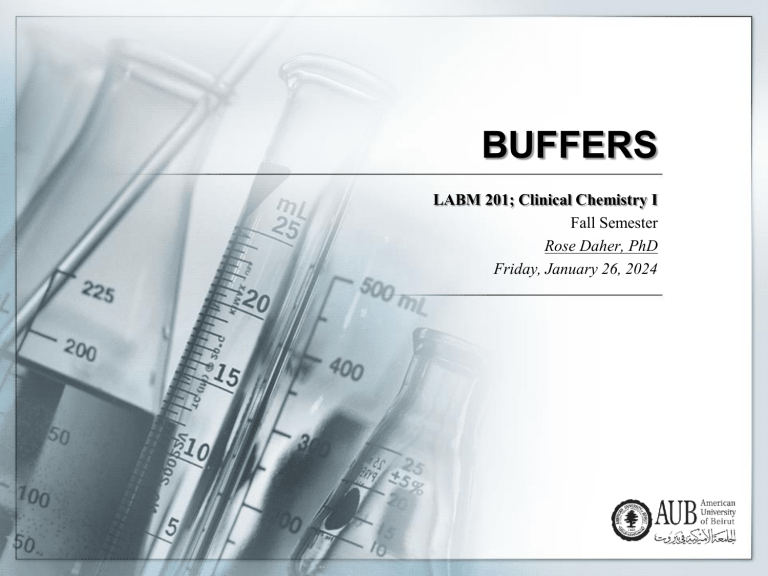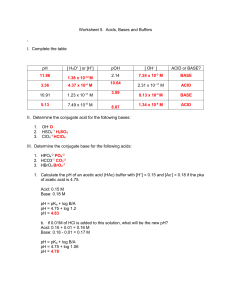
BUFFERS LABM 201; Clinical Chemistry I Fall Semester Rose Daher, PhD Friday, January 26, 2024 LECTURE OUTLINE 1. ACIDS AND BASES 2. ACID BASE EQUILIBRIUM 3. BUFFERS 4. POLYPROTIC ACIDS 5. EXERCISES 6. USEFUL SITE: HTTP://www.bio.cmu.edu/courses/03231/biochemF03.htm 2 Rose Daher, PhD Clinical Chemistry I 1. ACIDS AND BASES Acid: can donate a proton Base: can accept a proton Example: 3 Rose Daher, PhD Clinical Chemistry I 1. ACIDS AND BASES The compound M-O-H is an acid if it looses its proton a base if it releases an OH- group Whether a compound is an acid or a base depends on the relative strength of the M-O bond versus the O-H bond The strength of the acid increases with the electronegativity of M ↑ electronegativity more electrons are drawn from the OH group This electron density stabilizes the M-O bond Group I elements (Li, Na, K) all have electronegativities of one or less. Thus, the M-O bond is more ionic in nature and LiOH, NaOH, KOH are very basic When M is a non-metal (e.g. C, S, N, Cl) the compound is usually acidic The more electron-withdrawing M is, the stronger the acid 4 Rose Daher, PhD Clinical Chemistry I 1. ACIDS AND BASES Ethanol is very weak acid Acetic acid somewhat stronger Trichloroacetic acid is very strong. A quantitative measure of the strength of an acid is given by the acid dissociation constant, Ka Increased Acidity 6 Rose Daher, PhD Clinical Chemistry I 2. ACID BASE EQUILIBRIUM HA H+ + A- Henderson-Hasselbalch Equation 7 Rose Daher, PhD Clinical Chemistry I 2. ACID BASE EQUILIBRIUM pKa is dissociation constant for weak acids and depends on degree of dissociation, pH and temperature. Acid HCl Oxalic Acetic Ammoinium (NH4+) Methanol Benzene 8 pKa -7 1.23 4.76 9.25 16 30 Rose Daher, PhD Type Very strong Strong Weak Very weak Extremely weak Not really an acid Clinical Chemistry I 3. BUFFERS A buffer is something that resists change A pH buffer is a substance that permits solutions to resist large changes in pH upon the addition of small amounts of H+ or OH- ions Buffers play an important role in cellular processes because they maintain the pH at an optimal level for biological processes Strong acids are poor buffers Buffers must be Weak Acids or Weak Bases An acidic buffer contains a weak acid and a salt of the weak acid (conjugate base) A basic buffer contains a weak base and a salt of the weak base (conjugate acid) HA weak acid 9 H+ + Rose Daher, PhD Aconjugate base Clinical Chemistry I 3. BUFFERS The two species (conjugate acid and conjugate base) resist large changes in pH by partially absorbing additions of H+ or OH- ions to the system The amount of change depends on the strength of the buffer and the [A-]/[HA] ratio The buffering capacity of a weak acid is best at pH values near (within 1 pH unit of) its pKa The buffering capacity decreases as the dissociation becomes more complete 10 Rose Daher, PhD Clinical Chemistry I Titration Curve of 100 ml of Amino Acid solution 4. POLYPROTIC ACIDS Many compounds can release more than one proton in the pH range of 0-12 Examples are phosphate (pKa = 2.14, 7.20, 12.38), carbonate, and dicarboxylic acid If the pKa s are separated by 2 or more pH units (i.e. phosphoric acid) each ionization can be treated separately Depending on the structure of the polyprotic acid the pKa for each ionization can vary widely Acid Phosphoric Oxalic Succinic Carbonic 12 pK1 2.14 1.23 4.21 6.37 Rose Daher, PhD pK2 7.20 4.19 5.63 10.20 Clinical Chemistry I 5. EXERCISES 1. Calculate the pH of an acetate buffer composed of 0.2M sodium acetate and 0.05M acetic acid: HAc ↔ H+ + Ac- , pKHAc = 4.76 2. Prepare an acetate buffer whose concentration is 0.2M and has a pH of 5.0. pKHAc = 4.76; MWHAc = 60 g/mol; MWNaAc = 82 g/mol; buffer volume = 1 liter. 3. An enzyme-catalyzed reaction was carried out in 0.2M “Tris” buffer [Tris (hydroxymethyl) aminomethane] pH = 7.8. As a result of the reaction, 0.03 mol/L of H+ was produced. Tris+ → a. b. c. d. e. Tris0 + H+ ; pKa = 8.1 What was the ratio of Tris+ (Conjugate acid) / Tris0 (Conjugate base) at the start of the reaction? What are the concentrations of Tris+ and Tris0 at the start of the reaction? Show the reaction by which the buffer maintained a near constant pH? What are the concentrations of Tris+ and Tris0 at the end of the reaction? What was the pH at the end of the reaction? 13 Rose Daher, PhD Clinical Chemistry I 5. EXERCISES 4. Describe the preparation of 2 liters of 0.4M phosphate buffer pH = 6.9, starting from : a. 1.2M K2HPO4 solution and 2M H2SO4 solution H3PO4 → H+ + H2PO4-, Ka1 = 7.11 x 10-3 H2PO4- → H+ + HPO42-, Ka2 = 6.34 x 10-8 5. An enzyme catalyzed reaction was carried out in a solution buffered with 0.25M phosphate, pH = 7.2. As a result of the reaction, 0.05 mol/L of acid was formed. a. What was the pH at the end of the reaction? b. What would the pH be if no buffer were present? c. Write the chemical equation showing how the phosphate buffer resisted a large change in pH. 6. Calculate the volume of 0.2M sodium acetate and 0.2M acetic acid solutions required to prepare 100 ml, 0.2M acetate buffer, pH = 4.70 . Acetate buffer pKa = 4.76. 14 Rose Daher, PhD Clinical Chemistry I 5. EXERCISES 15 Rose Daher, PhD Clinical Chemistry I




